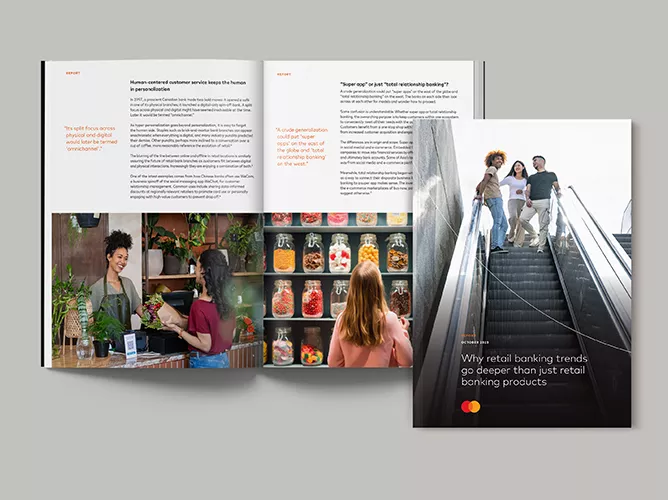By: Tancho Fingarov
Published: September 26, 2024 | Updated: September 26, 2024
Read time: 12 minutes
- Table of contents
Introduction
The obvious difference between a commercial business-to-business (B2B) payment and a retail consumer-to-business (C2B) payment is simply the payee. Why then should cards still be relatively uncommon for commercial payments in markets where they are common for retail payments?
To be clear, uncommon does not mean undynamic. On the contrary, Singapore’s card share of “cardable” domestic B2B payments, which excludes intracompany payments and any payments deemed infeasible for cards, increased 15-fold between 2017 and 2023.1 More modestly, Australia’s card share more than doubled over the same period.
The situation bodes well for cards. But it does not explain the anomalously low use of cards for B2B payments relative to their use for C2B payments.
Low card shares of “cardable” domestic B2B payments might make more sense in cash-dominant markets that are still largely also “uncarded” for retail. The negligible shares in the Philippines and Indonesia both hover relatively unchanged between 2017 and 2023.
Times are changing for the financial institutions issuing cards, and for the buyers and suppliers able to use cards
Still, all markets, and particularly the ones where cards predominate over cash in retail, warrant an explanation.
History provides a good starting point. Payment cards were designed for in-person retail C2B payments rather than invoice-based B2B payments, which represent the bulk of commercial payments. They then deftly accommodated e-commerce too, although only now is Click to Pay making online clicks as easy as offline taps.
Yet the lesson of history is not that commercial cards missed an opportunity.
Retail payments are generally low value with few stakeholders, while invoice-based commercial payments are generally high value with many stakeholders across “accounts payable” and “accounts receivable” departments. “Procurement” or “purchasing” cards known as P-cards — essentially non-revolving credit cards that link multiple cards to one business account — already handle any low-value B2B payments that do not involve invoices.
Yet times are changing for invoice-based payments:
- Commercial payments are growing. For example, China’s cardable domestic B2B spending grew by almost three fifths between 2017 and 2023. Meanwhile, China’s inbound and outbound cardable cross-border B2B spending grew by nearly a third.
- Commercial card payments are evolving. A virtual card number is a unique 16-digit card number that is generated from a real card number and has no physical counterpart. These virtual card numbers can also be tokenized for e-commerce or for contactless payments via digital wallets. Customized spending controls produce detailed data for tracking, reporting and automated reconciliation.
These changed times spell opportunities for the financial institutions issuing cards and for the buyers and suppliers able to use cards.
Where do commercial payments struggle?
Any discussion of cheques for commercial payments can be categorized alongside cash as increasingly immaterial in Asia. Across Australia, China, India, Indonesia, the Philippines and Singapore, only the Philippines saw an increase in total domestic cardable B2B spending on cheques between 2017 and 2023. Even then, the percentage of total share of spending was still single digits in 2023.
The bulk of commercial payments then comes from account-to-account electronic funds transfers (EFTs). Together, they account for over three fifths of cardable domestic B2B spending across Australia, China, India, Indonesia, the Philippines and Singapore.
The ability of an EFT to meet buyer and supplier needs can vary considerably based on its type
EFTs may involve net settlement or real-time gross settlement via an automated clearing house (ACH), or they may involve a wire transfer or real-time payment (RTP) directly between banks and ideally using ISO 20022 financial messaging when available. Yet, for all the electronic convenience of not having to pay an invoice in person or use a courier, an EFT is not necessarily anything more than its name suggests: a basic funds transfer.
Even RTPs on Mastercard-supported RTP networks in Europe, the Middle East, Asia, South America and North America, which can meet specific needs for instant and guaranteed domestic payments replete with standardized remittance information, still compromise in other areas. In the end, the ability of an EFT to meet buyer and supplier needs can vary considerably based on its type. Common problems include:
- Inefficient manual reconciliation if transaction data is not supported by sufficiently detailed information in financial messaging.
- Limitations around forecasting and compliance if real-time visibility into total transactions is lacking.
- No payment reversals for irrevocable RTPs, which pose an increased fraud risk if fraud prevention is not equally real time.
- No payment guarantees for ACH transfers coupled with delayed failure notifications for issues such as non-sufficient funds.
- Reduced working capital when funds are taken directly from bank accounts.
- Unavailable or cumbersome international payments, which may involve unclear and unexpected correspondent bank fees.
How can cards help commercial payments?
Commercial cards may be broken down into three main phases of evolution. The first phase with P-cards is not new, but it is evolving. The second and third phases, incorporating virtual cards and straight-through processing, are relatively new.
1. P-cards
Traditionally, P-cards are associated with low-value B2B payments. Astute corporate treasurers and card issuers then realized that the same approach could be used for high-value low-volume B2B purchases to cover “accounts payable” and “accounts receivable.” Invoice-based payments could then enjoy all the card-based benefits, which include:
- Deferred payments so buyers can keep money in their accounts for longer and also benefit from card-issuer rebates associated with spending volume.
- Detailed transaction data with one-to-one matches for efficient payment reconciliation.
- Cross-border payments on trusted international networks
- Payment guarantees without the need for buyers to validate and update supplier bank account information.
- Fraud protection and security via a payment network adhering to the payment card industry data security standard.
Card issuers and their corporate customers increasingly appreciate the benefits of card payments to commercial payments. Domestic B2B card spending more than doubled on average across Australia, China, India, Indonesia, the Philippines and Singapore between 2017 and 2023.
Nestled within that growth is a near tripling of virtual card spending over the same period.
2. Virtual cards
A virtual card offers several additional benefits beyond a P-card's benefits:
- Inherent security in single-use virtual card numbers that relieve the burden of having to handle or store sensitive payment credentials.
- Custom spending controls on single versus multi use, frequency of use, transaction amounts, types of purchase, locations and times of day.
- Fraud protection through automatic opening and closing of accounts based on valid start and end dates tied to custom controls.
- Instant and more environmentally friendly worldwide card issuance that eliminates the need for physical card distribution.
- Push provisioning of cards to digital wallets on mobile devices for instant use anywhere.
- Transparency of usage with enhanced transaction data, which includes non-financial information such as invoice numbers and billing codes, to support real-time tracking and reporting for automatic reconciliation across departments and spending categories.
The growth of virtual cards reflects market perceptions: 85% of bank executives believe virtual cards improve organizational processes, and 84% believe they enhance cybersecurity, according to RPMG’s 2022 virtual card benchmark survey results.
Virtual cards can also dovetail into straight-through processing, where available, for additional benefits.
3. Straight-through processing
A standard B2B card payment requires the supplier to input the received credit card information provided by the card issuer into the accounts receivable module of its enterprise resource planning (ERP) system. Straight-through processing (STP) for virtual cards is an emerging solution, already available in some markets, that bypasses this requirement by allowing the card network used by the issuer to provide a virtual card number directly to the supplier’s payment acquirer for processing.
The added benefits include:
- No need to manually input payment information.
- No need for manual exception handling when a payment fails.
- Reduced compliance challenges since the payment network rather than the supplier handles the virtual card number.
Where are the payment flows?
Virtual cards can benefit payment flows across all sectors from manufacturing and agriculture to construction and utilities. They may also extend into business to government (B2G) payments.
Four sectors warrant particular attention in terms of the benefits cards bring.
1. Wholesale & retail: tight margins
Domestic spending totals in the wholesale & retail trade category, which includes automotive repair, rank second in the Philippines and Singapore, third in China, and fourth in Australia, India and Indonesia across the eleven B2B sectors in the McKinsey Global Payments Map.
The B2B sales associated with wholesale & retail spending span the length of a supply chain and extend naturally into B2B2C sales. These relatively high volume and low value B2B sales tend to be similar to their B2C counterparts with similarly tight profit margins for businesses. On top of any payment agreements struck between buyers and suppliers, cards can help manage these margins by deferring payments of accounts payable while supporting the rapid reconciliation of accounts receivable.
Consistent handling of flows across B2B and C2B payments particularly makes sense for online marketplaces that straddle B2B and B2C sales. Pre-existing e-commerce support for C2B card payments can then make B2B integration comparatively easy.
2. Freight & logistics: dispersed stakeholders
Australia’s, China’s, India’s, Indonesia’s, the Philippines’ and Singapore’s domestic spending levels in the transportation & storage category in 2023 are below the levels seen domestically in the wholesale & retail category.
But the relationship between the two categories inverts if the focus is international rather than domestic. The long-distance spending covers chains of suppliers and buyers, local transporters, freight forwarders, terminal operators, customs brokers, port authorities and international carriers when exiting and entering jurisdictions.
The commercial payments, which may include B2G payments as well as B2B payments, that occur en route need to be guaranteed, error free, multi-currency, and able to handle last-minute payments of duties and fees at checkpoints without formal approvals or purchase orders. Virtual cards help through their instant provisioning on mobile devices regardless of location, spending controls to keep last-minute payments in check, and tying of payments to specific shipments that can then sync with ERP systems.
3. Healthcare: complex ecosystem
Singapore saw an almost six-fold increase in inbound cross-border cardable spending between 2017 and 2023 in the human health & social work activities category. The increase accords with Singapore’s second place ranking in the latest medical tourism index, which is based on American perceptions of healthcare destinations worldwide — America’s northern neighbor Canada ranked first.
Cross-border spending underlies pockets of intense growth, such as in Singapore. But healthcare spending at home and abroad is growing more generally too: 59% of health insurers in Asia Pacific believe healthcare costs will increase over the long term, according to WTW’s 2024 global medical trends survey.
Complexities include multiple public and private sector stakeholders, fragmented supplier bases including technology companies, minimal price transparency between providers and insurers, lots of highly variable data not always in standardized digital formats, and lengthy debt collection and claims cycles.
Unconsolidated overdue invoices are common. In this singularly complex sector, it is particularly important to be able to connect virtual card numbers from one account to disparate invoices for streamlined reconciliation and early delinquency warnings.
4. Digital & “as a service”: longtail spending
Everything from purchasing online advertising to renting cloud storage, is considered longtail spending, alternatively known as “non-strategic” spending. It consists of the bulk of a company’s B2B purchases across the largest number suppliers while accounting for only a fraction of the value of total spending.
Much of the cost to a business of handling these payments comes from the inefficiency of juggling multiple suppliers. The nature of digital and “as a service” payments make them more likely to be made to global suppliers operating in different currencies. They are also often subscription based with different payment terms and due dates that can be hard to manage.
A unique virtual card number for each subscription from a single funding account regardless of geography or currency can allow for consolidated views of spending. At the same time, the consolidation can open up volume-based spending rebates for buyers from card issuers.
What products and services boost the benefits of commercial cards?
The controls available to virtual cards represent more than just customizable restrictions around card use. They also give card issuers and businesses specific insights into their transparent real-time data. The ability to access and action those insights depends on the products and services that support the cards.
The benefits can span both parties: issuers can offer more competitive payment solutions; adopters can function more efficiently as buyers and suppliers. The cards are designed to stand alone by being easily embedded into existing payment flows. Still, virtual cards work best when supported by consulting solutions that offer holistic in-market and cross-market perspectives across entire commercial card strategies.
Solutions tend to begin with a common question from buyers and suppliers:
| “How can I gain insights to improve my working capital?” |
|---|
| A treasury analytics platform helps by cleansing and categorizing virtual card data in an ERP system alongside physical card and other transaction data, which includes payment network data on suppliers’ card acceptance preferences. Its consolidated dashboard can then provide full views of payment flows across all business units to improve working capital across buyer–supplier relationships and trade finance deals. |
Aware of how commercial cards can boost the performance of their clients’ treasury departments, card issuers can then ask:
| “Where is my commercial card portfolio underperforming?” |
|---|
| Insights reports offer external market and peer benchmarks across payment type, size, channel and time. Issuers can use the actionable, product-level market information from these insights to quantify their portfolio performance and identify areas for growth. |
Knowledge of the broader market context then leads issuers to a follow-up question:
| “How can I improve card acceptance and unlock client potential?” |
|---|
| A supplier enablement campaign addresses the question from two fronts: accounts payable and invoice data from buyers looking for efficiency; supplier card acceptance data from a payment network. A focus on suppliers with high transaction volumes, rather than just high total spending from a few big invoices, identifies opportunities for campaigns to encourage card use for increased supplier — and, by extension, buyer — efficiency. |
Once virtual card acceptance takes off, the question for suppliers and the card acquirers that support them is:
| “In what ways can I streamline the acceptance and processing of card payments?” |
|---|
| A receivables manager combines efficient processing, either through automated parsing of traditional payment information or ideally via straight-through processing, with the deliverance of enhanced remittance data to an ERP system. The receivables manager can then automatically match remittance data with open invoices and format everything according to the accounts receivable specifications of the ERP system. |
Conclusion: Redefining the commercial card issuer
Tight margins, dispersed stakeholders, complex ecosystems, longtail spending. The commercial benefits of virtual cards span the diverse needs of industries ranging from wholesale to healthcare at home and abroad. All the while, buyers can keep money in their accounts for longer, and suppliers can still receive payments on time. The efficiency and flexibility hinges on the card foundations and the supporting products and services provided by the underlying card network.
The buyer can then interface directly with the payment network to issue the virtual card number itself
Yet, while a virtual card number is quicker and easier to issue than a physical P-card, it still needs to be generated and transferred. That role traditionally falls to a commercial card issuer. After the buyer puts an invoice into its ERP system to submit as a payment instruction to the issuer, the issuer requests a virtual card number from the payment network and then sends the virtual card number to the supplier’s ERP system and the payment authorization status to the buyer’s ERP system.
Embedded finance offers an alternative by allowing the issuer to embed its issuing capabilities into a buyer’s ERP system. The buyer can then interface directly with the payment network to issue the virtual card number itself. In addition to improving efficiency, embedded finance also accords more control to buyers by giving them full insight into all the virtual card data in real time.
It is still novel, even anomalous, for buyers to act as issuers of commercial cards themselves. But that status is now changing — along with the status of the commercial payments they enable.
Contact us to learn from our team of commercial payments consultants and about our suite of related products and services: Commercial Card Insights, Supplier Enablement & Activation Service and Mastercard Receivables Manager (where available).












